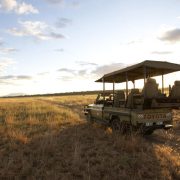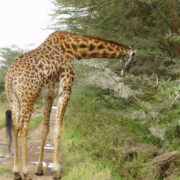NAIROBI NATIONAL PARK
- Uncategorized
- March 10, 2024
Nairobi National Park
A Unique Wilderness at the Heart of the City
Nairobi National Park holds the distinction of being Kenya’s first national park, established in 1946. This landmark achievement was the result of passionate campaigns led by conservationist Mervyn Cowie, who recognized the need to protect Kenya’s wildlife from the encroaching pressures of urbanization and poaching. The park’s establishment marked the beginning of Kenya’s long-standing commitment to conservation. Nairobi National Park is the only park within a country’s capital worldwide.
A Wilderness at the City’s Edge
Nairobi National Park is uniquely situated just 7 kilometers south of Nairobi, making it the only national park in the world that exists within the boundaries of a major city. The park’s proximity to the urban sprawl of Nairobi is remarkable; a mere 15-20 minute drive from the bustling Central Business District will transport you to a world where the rhythms of nature dominate, and the sights and sounds of the wild replace the city’s hustle and bustle.
This unique positioning offers visitors a rare opportunity to experience the thrill of an African safari without venturing far from the comforts of the city. The juxtaposition of the park’s wild landscapes against the backdrop of Nairobi’s skyline is a sight to behold, offering a visual reminder of the delicate balance between urban development and conservation.
Diverse Habitats and Ecosystems
Covering approximately 117 square kilometers, Nairobi National Park is a compact yet incredibly diverse reserve. The park’s landscape is a mosaic of different habitats, ranging from dense forests and acacia woodlands to open savannah grasslands and wetlands. This variety of ecosystems supports a rich array of wildlife, making the park a biodiversity hotspot within an urban setting.
The open savannahs, dotted with iconic acacia trees, are perhaps the most recognizable feature of the park. These grasslands are home to herds of herbivores, such as zebras, antelopes, and giraffes, which can often be seen grazing against the cityscape backdrop. The forested areas, on the other hand, provide shelter for more elusive species, including leopards and various primates.
Wetlands and rivers within the park, such as the Athi River, attract a multitude of bird species, making Nairobi National Park a haven for birdwatchers. The park is home to over 400 species of birds, including both resident and migratory species. From majestic raptors soaring overhead to colorful songbirds flitting through the trees, the avian diversity is truly impressive.
A Haven for Orphaned Elephants and Rhinos.
One of the most remarkable aspects of Nairobi National Park is its thriving population of black rhinos. Despite its relatively small size, the park is renowned for being one of the most successful sanctuaries for this critically endangered species. The black rhino population in the park is so well-protected and abundant that it serves as a source of rhinos for other parks and reserves across the country.
The success of the black rhino conservation efforts in Nairobi National Park is a testament to the effective management and anti-poaching measures implemented by the Kenya Wildlife Service. The park’s role in safeguarding these iconic animals is not only critical for the species’ survival but also serves as an inspiration for conservation efforts worldwide.
Although Nairobi National Park does not have resident elephants, visitors can still experience the majesty of these gentle giants by visiting the David Sheldrick Wildlife Trust, located within the park. The Trust operates an elephant orphanage that rescues and rehabilitates orphaned and injured baby elephants and rhinos.
The orphanage provides a safe haven for these young animals, many of whom have lost their mothers to poaching or human-wildlife conflict. Visitors to the orphanage have the unique opportunity to witness the daily care and feeding of the baby elephants, learn about the challenges they face, and see firsthand the efforts being made to ensure their survival. By nurturing and eventually reintroducing these orphans into the wild, the Trust plays a crucial role in preserving Kenya’s elephant and rhino populations for future generations.
Wilderness and Recreation
Nairobi National Park is not only a wildlife sanctuary but also a cherished recreational space for Nairobi’s residents and visitors. The park’s proximity to the city makes it a popular destination for nature exploration, picnics, and outdoor activities. The numerous picnic sites located at different points within the park provide ideal spots to relax and take in the surroundings, all while listening to the sounds of the wild and observing the vibrant birdlife.
A Wildlife Spectacle
Nairobi National Park is home to four of the famous “Big Five” game animals—leopards, lions, buffaloes, and rhinos—making it a prime destination for wildlife enthusiasts. On a lucky day, visitors can witness the powerful presence of these majestic animals within the park’s boundaries.
Lions, often referred to as the “kings of the jungle,” are among the most sought-after sightings in the park. These apex predators can be seen lounging in the shade or stalking prey across the savannah. Leopards, though more elusive, also inhabit the park and can sometimes be spotted resting in trees or moving stealthily through the underbrush.
Buffaloes, with their imposing size and formidable horns, are another highlight of the park’s wildlife. These herbivores can often be seen grazing in large herds, their sheer numbers creating an impressive sight. And, of course, the rhinos—both the endangered black rhino and the more commonly seen southern white rhino—are among the most treasured inhabitants of Nairobi National Park.
In addition, Nairobi National Park boasts an impressive variety of other wildlife species. Cheetahs, the fastest land animals, are sometimes seen sprinting across the open plains in pursuit of prey. Masai giraffes, with their long necks and distinctive coat patterns, are a common sight, gracefully moving through the savannah.
The park is also home to a variety of smaller mammals, such as hyenas, warthogs, and jackals, as well as a wide range of herbivores, including impalas, gazelles, and elands. This diversity of wildlife, coupled with the park’s proximity to the city, makes Nairobi National Park a truly unique destination where visitors can experience the thrill of an African safari just minutes from the urban core.
A National Treasure
In conclusion, Nairobi National Park is more than just a wildlife sanctuary; it is a national treasure that embodies Kenya’s rich natural heritage and commitment to conservation. Its unique location, diverse ecosystems, and thriving wildlife populations make it a must-visit destination for anyone traveling to Nairobi.
The park offers a rare blend of wilderness and accessibility, allowing visitors to experience the beauty and wonder of Africa’s wildlife without venturing far from the city. Whether you’re a seasoned safari-goer or a first-time visitor, Nairobi National Park promises an unforgettable experience that will leave you with a deeper appreciation for the natural world.
Recent Posts
First Time Safari in Africa: Complete Planning Guide
Masai Mara vs Serengeti: Which is Better?
NAIROBI NATIONAL PARK
All Categories
- Travel Tips (2)
- Uncategorized (1)
- Wildlife (2)



